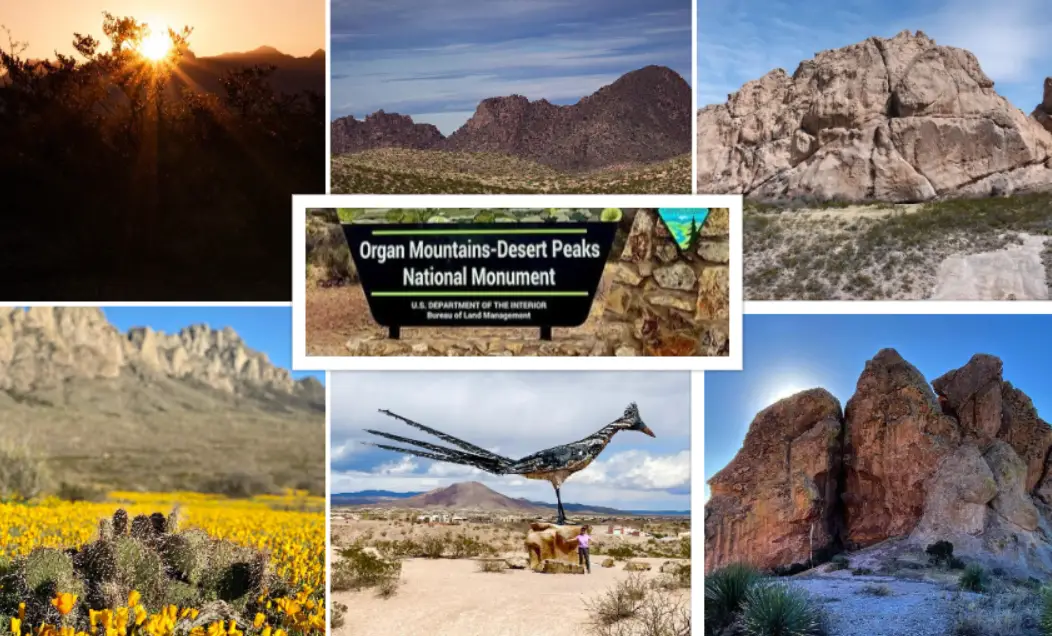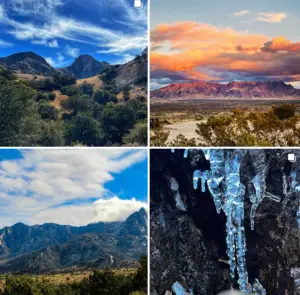Organ Mountains–Desert Peaks : Interesting Facts, History & Travel Guide

- By
- Aparna Patel
- |
- 13 Apr, 2023
- |

Nestled in the heart of southern New Mexico, the Organ Mountains–Desert Peaks National Monument is a stunning destination that’s filled with fascinating history, natural beauty, and exciting adventures.
This incredible landscape boasts towering peaks, sprawling deserts, and ancient cultural sites that have shaped the region for thousands of years. From hiking through rugged canyons to exploring ancient rock art, there’s something for everyone at this incredible destination.
In this blog post, we’ll take a deep dive into the Organ Mountains–Desert Peaks National Monument and provide you with interesting facts, historical insights, and a comprehensive travel guide to help you plan your visit. So pack your bags, put on your hiking boots, and let’s explore this natural wonder together!
Table of Contents
Interesting facts about Organ Mountains–Desert Peaks National Monument
- The Organ Mountains–Desert Peaks National Monument is located in southern New Mexico and covers over 496,000 acres.
- The monument includes four different areas: the Organ Mountains, Desert Peaks, Potrillo Mountains, and Doña Ana Mountains.
- The Organ Mountains are a prominent range that rises abruptly from the surrounding Chihuahuan Desert. They are known for their unique jagged appearance and steep canyons.
- The monument is home to a wide variety of wildlife, including mountain lions, black bears, mule deer, coyotes, and pronghorns.
- The area has a rich cultural history, with evidence of human occupation dating back over 10,000 years. The monument includes numerous archaeological sites, including rock art and petroglyphs.
- The monument is a popular destination for hiking, rock climbing, and camping, with over 100 miles of trails and numerous developed campgrounds.
- The monument was established in May 2014 by President Barack Obama, and was designated a national monument under the Antiquities Act.
- The monument is also home to numerous natural wonders, including unique rock formations, caves, and hot springs.
- The area has been used for a variety of purposes over the years, including ranching, mining, and military training. The monument includes several historic sites related to these activities.
- The Organ Mountains–Desert Peaks National Monument is an important conservation area, protecting a unique and diverse ecosystem in the heart of the Chihuahuan Desert.
Read More:
- Oregon Caves National Monument : Interesting Facts, History & Travel Guide
- Newberry Volcanic Monument : Interesting Facts, History & Travel Guide
- Muir Woods National Monument : Interesting Facts, History & Travel Guide
Information & History of Organ Mountains–Desert Peaks National Monument
The Organ Mountains–Desert Peaks National Monument is located in southern New Mexico and covers over 496,000 acres of land. The monument was established in May 2014 by President Barack Obama, and was designated a national monument under the Antiquities Act.
The monument includes four distinct areas: the Organ Mountains, Desert Peaks, Potrillo Mountains, and Doña Ana Mountains. The Organ Mountains rise abruptly from the surrounding Chihuahuan Desert and are known for their unique jagged appearance and steep canyons. The Desert Peaks include a variety of volcanic formations, while the Potrillo Mountains are characterized by rugged lava flows. The Doña Ana Mountains are a smaller range located near the city of Las Cruces.
The area has a rich cultural history, with evidence of human occupation dating back over 10,000 years. The monument includes numerous archaeological sites, including rock art and petroglyphs. The area has been used for a variety of purposes over the years, including ranching, mining, and military training. The monument includes several historic sites related to these activities.
The Organ Mountains–Desert Peaks National Monument is home to a wide variety of wildlife, including mountain lions, black bears, mule deer, coyotes, and pronghorns. The area is also an important stopover for migratory birds, with over 200 species recorded in the monument.
The monument is a popular destination for hiking, rock climbing, and camping, with over 100 miles of trails and numerous developed campgrounds. The area has also been used for filming, with several movies and television shows shot in the area over the years.
The Organ Mountains–Desert Peaks National Monument is an important conservation area, protecting a unique and diverse ecosystem in the heart of the Chihuahuan Desert. The monument is managed by the Bureau of Land Management, and works closely with local communities to ensure the sustainable use and protection of the area’s resources.
Travel Guide for Organ Mountains–Desert Peaks National Monument
If you’re planning a trip to the Organ Mountains–Desert Peaks National Monument, here are some travel tips to help you make the most of your visit:
- When to visit: The best time to visit the monument is in the spring or fall, when temperatures are milder and the weather is generally more pleasant. Summer can be very hot, while winter can be cold and snowy.
- Getting there: The monument is located about 15 miles northeast of Las Cruces, New Mexico, and can be reached via Interstate 25. The closest major airport is in El Paso, Texas, which is about an hour’s drive away.
- What to do: There are many activities to enjoy in the monument, including hiking, rock climbing, camping, and wildlife viewing. Some of the most popular hiking trails include the Dripping Springs Trail, the Soledad Canyon Trail, and the Baylor Pass Trail. If you’re interested in rock climbing, the area around the Organ Mountains offers a variety of routes for climbers of all skill levels.
- Where to stay: There are several developed campgrounds within the monument, including Aguirre Spring Campground, which offers stunning views of the Organ Mountains. If you prefer more amenities, the nearby city of Las Cruces offers a variety of hotels and motels.
- Safety tips: When visiting the monument, be sure to bring plenty of water and sunscreen, as temperatures can be very hot, especially in the summer. You should also be aware of wildlife in the area, including snakes, mountain lions, and bears, and take appropriate precautions.
- Other attractions: If you have time, be sure to also visit nearby attractions, such as White Sands National Park, the Gila National Forest, and the city of El Paso, Texas.
Overall, the Organ Mountains–Desert Peaks National Monument is a beautiful and unique destination, offering a wide variety of activities for visitors to enjoy. Whether you’re interested in hiking, rock climbing, or simply enjoying the natural beauty of the area, the monument is a must-see destination for anyone visiting southern New Mexico.
More Post
- Mount St. Helens Volcanic : Interesting Facts, History & Travel Guide
- Montezuma Castle National Monument : Interesting Facts, History & Travel Guide
- Mojave Trails National Monument : Interesting Facts, History & Travel Guide
- Misty Fjords National Monument : Interesting Facts, History & Travel Guide
FAQ about Organ Mountains–Desert Peaks National Monument
What is the Organ Mountains–Desert Peaks National Monument?
The Organ Mountains–Desert Peaks National Monument is a protected area of over 496,000 acres in southern New Mexico. It was designated a national monument in 2014 by President Barack Obama.
What is there to do in the monument?
There are many activities to enjoy in the monument, including hiking, rock climbing, camping, and wildlife viewing. Some popular hiking trails include the Dripping Springs Trail and the Soledad Canyon Trail, while rock climbers can explore the area around the Organ Mountains. There are also several developed campgrounds in the monument.
What is the best time to visit the monument?
The best time to visit the monument is in the spring or fall, when temperatures are milder and the weather is generally more pleasant. Summer can be very hot, while winter can be cold and snowy.
Is there a fee to enter the monument?
No, there is no fee to enter the monument.
What should I bring with me when visiting the monument?
You should bring plenty of water and sunscreen, as well as appropriate clothing and footwear for hiking and outdoor activities. You should also be aware of wildlife in the area and take appropriate precautions.
Can I bring my dog with me to the monument?
Yes, dogs are allowed in the monument, but they must be on a leash at all times.
Are there any nearby attractions worth visiting?
Yes, there are several nearby attractions worth visiting, including White Sands National Park, the Gila National Forest, and the city of El Paso, Texas.
Is the monument accessible for people with disabilities?
There are some accessible facilities and trails in the monument, but not all areas may be accessible for people with disabilities. It is recommended to check with the monument beforehand to plan your visit accordingly.
Search Posts
Latest posts
-
5 Mar, 2024
Why prohibit engine braking?
Popular posts
-
5 Mar, 2024
Why prohibit engine braking?